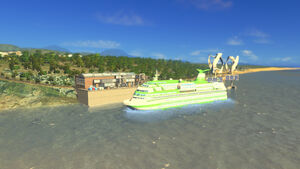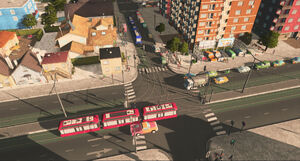Cities Skylines How to Raise Train Tracks

Passenger ship about to dock
Public transport allows traveling for citizens, decreasing the number of private vehicles on the road and alleviating traffic and traffic-created noise pollution. Transportation come in various methods: bus stations, metro stations, train stations, airports, harbors, and taxi stands.
[1]
Transportation can be used for various purposes:
- Intra-city transport (commuter, tourist, cargo)
- Inter-city transport (tourist, cargo)
The Space Elevator is a monument to attract tourists. It is labelled as 'Public Transport'.
Contents
- 1 Types of transportation
- 1.1 Airports
- 1.2 Blimp
- 1.3 Bus
- 1.3.1 Bus lanes (roads)
- 1.4 Cable Cars
- 1.5 Tram
- 1.5.1 Tram tracks
- 1.6 Metro
- 1.7 Train
- 1.8 Harbor
- 1.9 Monorail
- 1.10 Taxi
- 1.11 Gallery
- 1.12 References
Types of transportation [ ]
Airports [ ]
Airports are a mode of public transport that can take tourists to your city. Although creating heavy noise pollution, they will help your city to gain more tourists.
| Building | Cost | Upkeep | Pollution | Noise Pillution | Unlock |
|---|---|---|---|---|---|
 | 150,000 | 4800 per week | 0 | 150 | Metropolis |
| | 250,000 | 8000 per week | 0 | 175 | Megalopolis |
 | 250,000 | 3,000 per week | 0 | 150 | Metropolis |
 | 250,000 | 4,000 per week | 0 | 200 | Megalopolis |
Blimp [ ]
Only with Mass Transit DLC
Each blimp has a capacity of 35 passengers, just 5 more than buses. You need to mark Pathways for the blimps to travel. Blimps fly from stop to stop and need a route to the Blimp Depot. Pathways are two-way, basically like virtual roads for Blimps. Stops need a road connection, but other than that, can freely be placed anywhere on the map. Depots need to be connected to roads as well, but can send vehicles to any line they have a Pathway connection with.
As an extra benefit, there is space on the sides of Blimps for advertisements. By default they show adverts from various companies, but if you wish to use the space to your city's benefit, you can set a policy so that Blimps show educational posters. This boosts your city's education facilities a little bit.
| Building | Cost | Upkeep | Pollution | Noise Pollution | Unlock |
|---|---|---|---|---|---|
 | $20,000 | $264/week | 0 | 100 | None |
 | $16,000 | $264/week | 0 | 75 | None |
Bus [ ]

Bus services allow citizens to travel in a public vehicle through designated stops. Bus depots can sustain an unlimited amount of buses, in the expense of a hefty price for purchasing bus depots. Bus lines are travel routes with designated stops, created by placing bus stops around a city and looping it back to the starting position.
| Building | Cost | Upkeep | Pollution | Noise pollution | Unlock |
|---|---|---|---|---|---|
| Bus depot | ₡30,000 | ₡720/week | 0 | 50 | Boom Town |
| Bus station (After Dark DLC) | ₡65,000 | ₡1,200/week | 0 | 75 | Busy Town |
 | $40,000 | $960/week | 0 | 25 | None |
Bus lanes (roads) [ ]
Bus lanes road are found in the road section or the bus section in transportation. Having these roads are good to have since buses and even taxis can go on these lanes unless if they are about to turn right. The only disadvantage is that other vehicles are forced to move to the other lanes which may turn that into heavy traffic.
| Road | Cost per cell | Upkeep per cell | unlock |
|---|---|---|---|
Four-Lane Road with bus lanes | ₡60 | ₡0.80 | Boom Town |
Six-lane Road with bus lanes | ₡80 | ₡0.96 | Boom Town |
Cable Cars [ ]
Only With Mass Transit DLC
The Cable Cars are very useful on steep slopes, but can also be placed on level ground. They can be used to cross rivers or other bodies of water if you want. There are two types of stops: end-of-line stops and stops where Cable Cars can pass through and continue to further stops. Pass through stops can also be used at the ends. Cable Cars lines are somewhat easier to set up than other types. Build the stops you want to have in the city and connect them with cables. When any two or more stops are connected, the line will start to operate automatically. All stops connected to each other are considered one line. Cables can go over roads and their height can be adjusted with PgUp and PgDown, just like roads. However the cables cannot pass over houses. Cables can be built on water, even so that the concrete bases of the pylons are standing in the water.
Cable Cars don't have a huge capacity, but they run often, allowing a constant stream of passengers to be transported. It's best for steep slope travelling, since cars and roads can't go on steep places.
Tram [ ]

Trams

Tram services are available in Cities: Skylines Snowfall. Trams operate on tracks and are stationed in tram depots when inactive. Tram tracks can be built on existing roads with versions of the tracks. Tracks can also be standalone with no road beneath them. Trams are capable of transporting 90 passengers with vanilla trams. However, unlike buses, trams have nearly 15% higher upkeep costs per distance traveled. Trams are not hindered by snow.[2] They are more costly to maintain than buses.
| Building | Cost | Upkeep | Pollution | Noise pollution | Unlock |
|---|---|---|---|---|---|
| Tram depot | ₡40,000 | ₡768/week | 0 | 75 | Boom Town |
Tram tracks [ ]
There are different varieties of them some by themselves or either along a road. The most disadvantage about this is that they don't have a six-lane road version for it compared to the six-lane road with bus lane (see buses)
| Road | Cost ₡/cell | Upkeep ₡/week/cell | Speed limit | Description | Unlock |
|---|---|---|---|---|---|
| | ₡70 | ₡0.56 | 40 | A two-lane road with tram tracks. Supports low traffic. | Boom Town |
| | ₡60 | ₡0.56 | 40 | A two-lane, one-way road with tracks for trams. Supports low traffic. | Boom Town |
| | ₡100 | ₡1.36 | 50 | A four-lane road with tram tracks. Supports medium traffic. | Boom Town |
| | ₡65 | ₡0.48 | 40 | Standalone tram track with rails for both directions. | Boom Town |
| | ₡45 | ₡0.32 | 40 | Standalone one-way tram track. | Boom Town |
Metro [ ]

Metro services are underground transportation, suitable for heavily populated and largely condensed cities. Metros can be added by placing a metro station. Metros travel through tunnels, which can be created through the tunnel tool and work similarly to the road system. Like buses, metros require loops to be created in order for citizens to travel.
An International Airport has one inside it.
As of the Sunset Harbor free patch, metro lines can now be placed above ground, and even be elevated above the ground. Two new types of metro station were made to accommodate these new ways of placing lines. The size of the existing underground metro stations were also changed, making them longer. The original metro stations still work as normal in old cities.
| Building | Cost | Upkeep | Pollution | Noise pollution | Unlock |
|---|---|---|---|---|---|
| | ₡15,000 | ₡240/week | 0 | 50 | Big Town |
| | ₡100/cell | ₡0.64/week/cell | 0 | 0 | Big Town |
Train [ ]

Trains use the railway system that allows both passenger travel and cargo travel through land. Train tracks can be placed throughout the city to allow traveling.
| Building | Cost | Upkeep | Pollution | Noise pollution | Unlock |
|---|---|---|---|---|---|
| Train station | ₡45,000 | ₡960/week | 0 | 115 | Small City |
| Cargo train terminal | ₡60,000 | ₡1,440/week | 0 | 115 | Small City |
| Train tracks | ₡60/cell | ₡0.96/week/cell | 0 | 0 | Small City |
Harbor [ ]
Harbors are water-based transport that may carry passengers and cargo coming from outside sources. Ships do not need routes, but they do require a path to and from harbors and outside connection.
| Building | Cost | Upkeep | Pollution | Noise pollution | Unlock |
|---|---|---|---|---|---|
| Harbor | ₡80,000 | ₡1,600/week | 0 | 120 | Capital City |
| Cargo harbor | ₡60,000 | ₡1,920/week | 0 | 120 | Capital City |
| Cargo hub (After Dark DLC) | ₡90,000 | ₡2,400/week | 0 | 120 | Colossal City |
Monorail [ ]
Only With Mass Transit DLC
Each monorail has a capacity of 180 passengers, 2x more than trams and 6x more than buses. For the monorail, you need to build stations. Monorails can be built on top of roads. A new avenue type has been added with monorail tracks going on top of the section between lanes. This avenue is just like a regular road, so that you can easily upgrade existing roads to use it. While the monorail has stand-alone stations that work just like stations for any other transport type, you can also place it on top of a road. The tracks also work without a road, so you can connect sections of stand-alone track and sections of track on top of an avenue. Like with the updated train tracks, both one- and two-way monorail tracks are available.
| Building | Cost | Upkeep | Pollution | Noise Pollution | Unlock |
|---|---|---|---|---|---|
 | $15,000 | $240/week | 0 | 80 | None |
Taxi [ ]
Taxi services are available in Cities: Skylines After Dark. Taxi mainly serves as tourist transportation and are highly recommendable for commercial districts. Taxis are available through taxi depots. Unlike bus and metro lines, taxis wait for calls from citizens by waiting in taxi stands and begin traveling to the citizen when called for.
| Building | Cost | Upkeep | Pollution | Noise pollution | Unlock |
|---|---|---|---|---|---|
| Taxi depot | ₡15,000 | ₡160/week | 0 | 100 | Boom Town |
| Taxi stand | ₡1,000 | ₡16/week | 0 | 10 | Boom Town |
Gallery [ ]

Trams

Trams
References [ ]
- ↑ Cities: Skylines. Paradox Interactive. In-game information.
- ↑ "Cities: Skylines - Snowfall - Dev Diary 2: New Things on the Roads". Paradox Interactive. 27 January 2016.
Cities Skylines How to Raise Train Tracks
Source: https://skylines.fandom.com/wiki/Public_transport


















0 Response to "Cities Skylines How to Raise Train Tracks"
Post a Comment